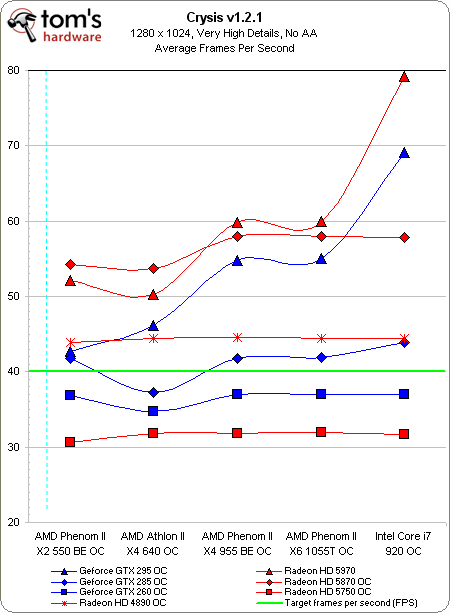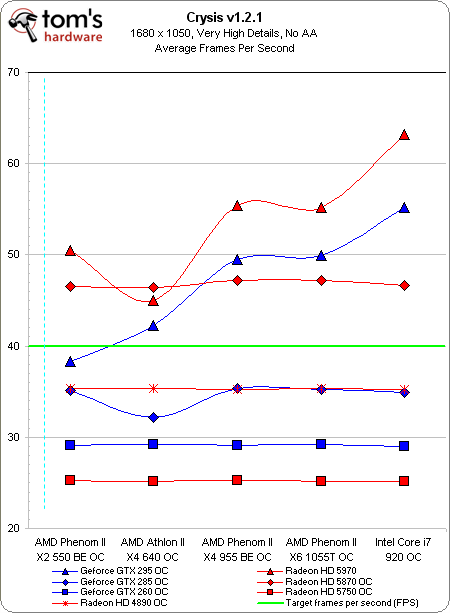Part 4: Building A Balanced Gaming PC
What does it mean to build a truly-balanced PC? How great would it be to piece together a machine bottlenecked by neither CPU or GPU? We set forth to measure the perfect balance in seven different games and four resolutions in this fourth of many parts.
Benchmark Results: Crysis
Crysis:
First up…Crysis. Although this first-person shooter was released in November of 2007, it still arguably represents one of the most graphically-demanding games out there. We needed to settle for less-than-maximum eye candy just to achieve any level of playability, so our compromise was to test at Very High detail levels and no AA, rather than drop to High details and enable AA.
Utilizing our normal benchmark tool provides a good combination of graphical eye candy and physics effects. Our typical target has been 40 FPS, but we put that foregone conclusion to the test in preparation for this series, playing and FRAPS benchmarking numerous configurations in three of the most demanding levels of the game.
The 40 FPS target remains our recommendation. Although Crysis is still quite playable at less than 40 FPS, there will be areas in levels like “Paradise Lost” and “Assault” where framerates will drop into the mid 20s. We feel the 40 FPS recommendation is a safe bet for acceptable performance, although the possibility still exists that stuttering during the game’s closing battle in “Reckoning” could require settings to be tuned down just a bit.
This resolution has belonged to the Radeon HD 4890 and any of the nine overclocked processors visited thus far prove to be a good match. Paired with enough processor muscle, the Radeon HD 5870 is able to provide an additional 14 FPS on average. At this low resolution, it’s only with the Core i7 that the two dual-GPU cards are able to pull away from the Radeon HD 5870.
We see mixed results comparing the cheapest two AMD processors. The GeForce GTX 295 continues to be a poor solution for dual-core processors, while most of the other cards benefit from the Phenom II X2’s L3 cache more than from the Athlon II X4’s extra cores.
If you are looking to dig out Crysis and see it in all of its glory, prepare to drop a good chunk of change on graphics. The Radeon HD 5870 is the only one of our single-GPU cards to remain playable at even a modest 1680x1050 resolution. Luckily, if you are willing to overclock, adequate performance can still be squeezed from an inexpensive CPU. Reaching our target with the GeForce GTX 295 requires a platform boasting four or more processing cores, while the Radeon HD 5970 again looks to suffer from the Athlon II’s lack of L3 cache.
Get Tom's Hardware's best news and in-depth reviews, straight to your inbox.
Our overclocked Radeon HD 5870 would likely still handle 1080p quite well, but 1920x1200 tempts us to bump up voltages and seek higher graphics core speeds. The reality of the situation is that, at this resolution, we have now entered dual-GPU territory. While the GeForce GTX 295 and Athlon II X4 640 are the cheapest combo to crest our target line, we see a dual-core Phenom II and Radeon HD 5970 pairing offer more performance.
At 1920x1200, we have sufficient GPU demands to no longer see any gain from stepping up to the overclocked Core i7. So basically, the overclocked Phenom II X4 955 BE is all the CPU needed to squeeze maximum performance from the top two graphics cards.
All of today’s platforms fall far short of offering playable performance at 2560x1600. Once again, framerates occasionally slowed to a crawl, causing the sporadic variations on the GeForce cards.
Current page: Benchmark Results: Crysis
Prev Page Overclocking, Test System Configuration, And Benchmarks Next Page Benchmark Results: Far Cry 2-
wildeast "such as NVidia’s GeForce GTX 400-series and revamp the benchmark suite with some new DirectX 11 titles."Reply
i'll be waiting for that, and maybe some i5 cpu to see what fit sli best -
jsowoc "We set forth to measure the perfect balance in seven different games and four resolutions in this third of many parts." (?)Reply
I think you copied this paragraph from part 3 and forgot to change it to 4... ;-) -
theshonen8899 With the amount of love you guys have for the Athlon x3 I was really hoping to see it on here :\Reply
I guess I can kind of predict where it'd fall though. -
L0tus Brilliant piece.Reply
I wish I had read this before building my system as I can see that I clearly spent too much on my CPU instead of GPU (i5-750 + HD5770) . Would have done much better with (X2 550 BE + HD5850) !
...ain't hind sight a b***h!
Also interesting to see how GPUs really start to distinguish themselves at higher resolutions. Again, brilliant work. -
TheStealthyOne I built a computer for my brother using a Phenom ii 550 paired with a 5770, and it screams! Fantastic gaming chip! It just goes to show you can achieve fantastic performance by planning and balance.Reply -
garlik_bread Personally, i'd be interested to see results from a card with less han 1GB RAM on the GPU.Reply
On the lower end of the spectrum, with the lower resolutions, is the 1GB really necessary?
Basically, i have a 512MB Asus 5770 and want to validate my purchase :D -
plasmastorm Still running a Maximus formula 775 board with a Q6600, 8gb ram and a Radeon 5850 but this is certainly handy for future reference.Reply
Probably skipping the i5/i7 generation as I can still play anything at max settings on my 22" monitor while running a 2nd for a film tho :) -
descendency plasmastormStill running a Maximus formula 775 board with a Q6600, 8gb ram and a Radeon 5850 but this is certainly handy for future reference.Probably skipping the i5/i7 generation as I can still play anything at max settings on my 22" monitor while running a 2nd for a film thoReply
i5/i7 isn't a generation. it's like 5 or so.
It's the same thing as C2D and C2Q



